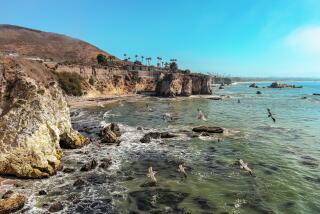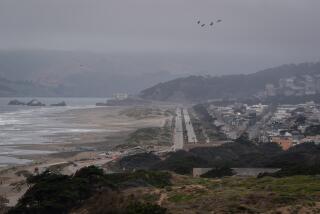A Helping Hand for Upper Newport Bay : Federal Project to Clear Sediment So Wildlife Can Survive Would Be Welcome Change
- Share via
Upper Newport Bay is one of the jewels of Orange County’s natural landscape. Nature lovers come to witness its endangered birds, runners survey scenic bluffs and flats, and the vast 752-acre ecological reserve provides a pleasing visual respite from the rush and development of life in and around Newport Beach.
Now the Army Corps of Engineers has begun a much-needed study of sedimentation problems of the bay that result from mounting pressures of urban runoff. Development has caused more silt to flow in, and without dredging and control, the silt would choke the bay and dry it up. Moreover, the life of the bay is threatened by fertilizers that are washed in from upstream sources. This in turn encourages algae growth, which consumes oyxgen and harms fish. Litter and the daily intrusion of visitors can damage the soil.
In all, an estimated 2 million visitors come to the reserve each year, and the stresses of development have taken their toll. That’s why the Corps’ one-year study is so important to assess the impact of sediment deposits. Under the Water Resources Development Act of 1986, the Corps is authorized to consider dredging and maintaining a 250-foot-wide channel that would preserve the flow of materials and facilitate navigation.
Up to this point, the Upper Newport Bay has been the subject of numerous protests, court hearings and purchase by the state to have the bay designated a wildlife haven in 1975. Already, efforts in 1980 have resulted in the digging of basins and channels to improve tidal flow, and the construction of islands as nesting sites for the California least tern. But the current project is important because of silt that has built up in recent years in parts of the bay. This preliminary study can lead to the dredging and clearing of debris that chokes the waterway and threatens its vitality.
The previous commitment of the state to buy the preserve, and the willingness of the Irvine Co. to donate bay-front acreage for a county park, are some of the past cooperative efforts that have helped save the bay. The current problem of sediment collection goes to the heart of the viability of the estuary as a living entity.
There has been a timely change in thinking in Washington, as past funding priorities often have gone only to improving navigation and storm drainage. But now, as a result of some environmental consciousness-raising, the use of federal funds for the preservation of wildlife habitat is a possibility. This Corps study is a most welcome indication that times are changing.
More to Read
Sign up for Essential California
The most important California stories and recommendations in your inbox every morning.
You may occasionally receive promotional content from the Los Angeles Times.










